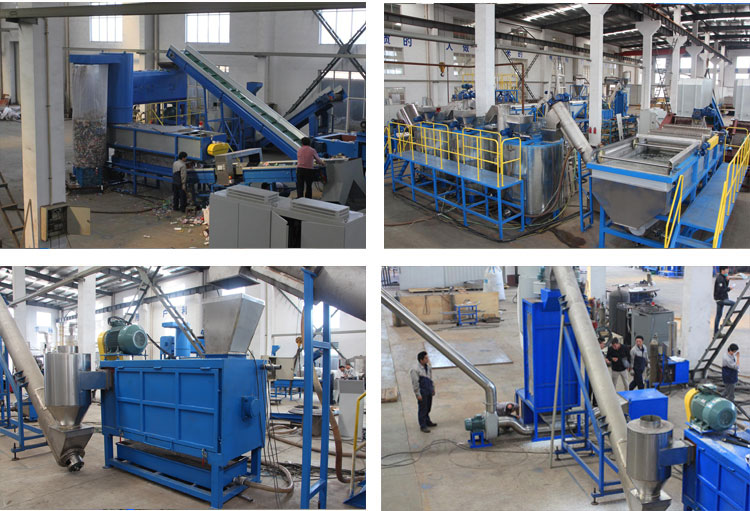
Professional Manufacturer of
Plastic Machinery and Waste Sorting Machine
Plastic Machinery and Waste Sorting Machine
+86 13962258685(What’s app/Wechat)

+86 13962258685(What’s app/Wechat)

DESCRIPTION
Our standard PET bottle washing line is your complete solution for turning dirty bales of PET bottles into clean PET flakes ready for usage in producing polyester staple fiber or further processing into plastic granules via pelletizing. We offer standard washing capacities from 500kg/h up to 3000kg/h and can also manufacture custom wash lines with greater capacities.
APLUS‘s PET recycling line is fully automatic where each piece of recycling machinery is connected via the use of either belt or screw conveyors. In addition, the entire washing line is controlled via a central electric control panel and cabinet.
1. Debaler Machine – As PET bottles (with caps & labels) often come in bales, compacted bundles tied together with metal wires, the first stage is to get the material into a “free flowing” stream. The “debaler” breaks apart the bales allowing the plastic bottles within to drop onto the belt conveyor that moves the bottles onto the next step.
2. Trommel Separator – A large, slow rotating machine used to remove small pieces of contamination. At the core of the trommel separator is a large mesh screen tunnel that rotates between 6-10 rotations per minute. The holes on this tunnel are small enough so the PET bottles will not fall through, however, large enough so small particles of contamination.
3. Wet Granulator / Crusher – The bottles are cut into “flakes”, or small pieces, via our wet granulator. Simply put, a granulator uses an open rotor mounted with heavy-duty knives that spin at high speeds. As the PET bottles enter the granulator’s cutting chamber, these rotating knives come into contact with stationary knives cutting the bottles into small pieces. A screen with small holes between 12-18mm in diameter is used to control the size of the flakes; That is, the PET plastic will continue to be cut within the chamber until it is small enough to fall through the holes on this screen. All the while, water is sprayed into the cutting chamber partially washing the bottles while acting as a lubricate to reduce friction of the knives and plastic.
4.Label Separator – The stream of plastic leaving the granulator is composed of PET flakes, paper and PP/PE/PVC film from the labels, and PP/PE rigid plastics from the bottle caps. This mixed stream is now ready to be sorted. The first step is the label separator where a column of pressured air blows away the lighter paper and plastic film into a separate collection tank.
5.Sink / Float Separation Tank – A large tank of water used to separate materials that sink from those that float. This is the final separation equipment in our PET bottle washing line that effectively removes the left over plastic films from labels and PP/PE bottles caps. As both the labels and bottle caps float in water, the sinking PET flakes can easily be removed to be further processed in the next piece of equipment.
6.Hot Washer For PET Flakes – Similar to a washing machine in nature, this stream of PET flakes are washed using boiling hot water which sterilizes and further gets rid of contaminants such as glues (from the labels being glued on), grease/oils, and difficult to remove left-overs (beverage/foods) from the equation.
7.Friction Washer – A secondary friction washer (cold water) is used to cool and further clean the PET flakes in a scrubbing manner.
8.High Speed Dewatering Machine – The dewatering machine uses centrifugal or “spinning” force to remove a portion of the water from the PET flakes. It’s a cost-effective way to dry the PET flakes before it’s thermally dried. Thermal drying consumes much more energy.
9.Thermal Dryer + Cyclone Separator – The partially dried PET flakes can now be completely dried using the thermal dryers. Within the long tubes of the thermal dryers, hot air and the PET flakes are mixed together where the leftover moisture is dehydrated. The final cyclone separator mixes the hot, moist air with a flow of cold air cooling the PET flakes in preparation for storage. The cyclone separator is also the last defence against fines such as dust.
10.Product Silo – A large storage tank for the clean, dry PET flakes.
Pelletizer / Extruder – As most PET bottle recycling lines are used to produce clean flakes for use directly in producing polyester staple fibre, we leave the pelleizing equipment as an optional piece in our washing line. APLUS offers both single-screw and double-screw extruders for this purpose.
Model&Technical specifications
|
Input Capacity
|
500kg/hr
|
1000kg/hr
|
1500k/hr
|
2000kg/hr
|
|
Dimension
|
45m*15m*6m
|
50m*15m*6m
|
55m*16m*6m
|
60m*18m*6m
|
|
Operator
|
4-5
|
5-6
|
6-8
|
8-10
|
|
Installation power
|
180KW
|
299KW
|
370KW
|
450KW
|
|
Water cycle (T / h)
|
3
|
4
|
6
|
8 |
Link: Cargo Elevator Municipal solid waste machine garbage sorting machine waste separating machine waste sorter vinyl acetate monomer polyvinyl alcohol PVA VAM Passenger Elevator waste sorting machine Home Elevator passenger elevator Hospital Elevator Dumbwaiter Escalator Moving Walks Elevator Cabin Elevator Parts Home Elevator elevator lift hospital elevator panoramic elevator Panoramic Elevator